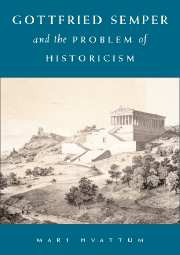Epilogue
Published online by Cambridge University Press: 06 August 2009
Summary
The dream of fully capturing one's own horizon of understanding, and objectifying the presupposition for understanding itself, was one that could not have succeeded. As Vesely points out, “in order to do so, it would have been necessary to transform the whole culture to which architecture inevitably belongs into verifiable conditions and to make them part of a complete functional system.” Semper himself implicitly testified to this recognition by the incompleteness of his project. “I can assure you,” he wrote to his impatient publisher awaiting the third volume of Der Stil, “that it was not carelessness, indifference, and certainly not ill will, but motives and emotions of quite a different nature that prevented me again and again from fulfilling … the obligations I have towards you and the public”. In this epilogue, I would like to touch upon these ‘feelings and motives’, to scrutinise more closely, that is, the inherent limits of a ‘science of architecture’.
This investigation takes us back to Kant, whose Critiques were precise attempts to investigate the inherent limits of human reason. Knowledge, for Kant, was possible only insofar as intuition – received through the sensate faculty – can be subordinated under laws given by the understanding itself. Our knowledge of the phenomenal world is restricted to those aspects of it that can be subsumed under the categories of the understanding, such as cause and effect, substance, and so on.
- Type
- Chapter
- Information
- Gottfried Semper and the Problem of Historicism , pp. 189 - 192Publisher: Cambridge University PressPrint publication year: 2004

